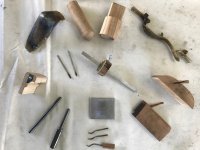Good morning from Bowling Green KY. I'm enrolled in the National Muzzle Loading Association's annual Gun Building Workshop hosted by WKU. While technically I'm in the tool making workshop, I may spend a few days brass casting with Dr. Terry Leeper (sp).
Everyone is familiar with the Girandoni air gun that Lewis & Clark carried on their field trip/See America Tour, right? Well, I learned that the metallurgy was poor and the material was sold by the King's brother to Girandoni. Wrought iron for its air flask and internal parts made with wrought iron contributed to its failure (in the Austrian Army) and parts breakage.
You can learn so much from the students attending the seminar.
Everyone is familiar with the Girandoni air gun that Lewis & Clark carried on their field trip/See America Tour, right? Well, I learned that the metallurgy was poor and the material was sold by the King's brother to Girandoni. Wrought iron for its air flask and internal parts made with wrought iron contributed to its failure (in the Austrian Army) and parts breakage.
You can learn so much from the students attending the seminar.

